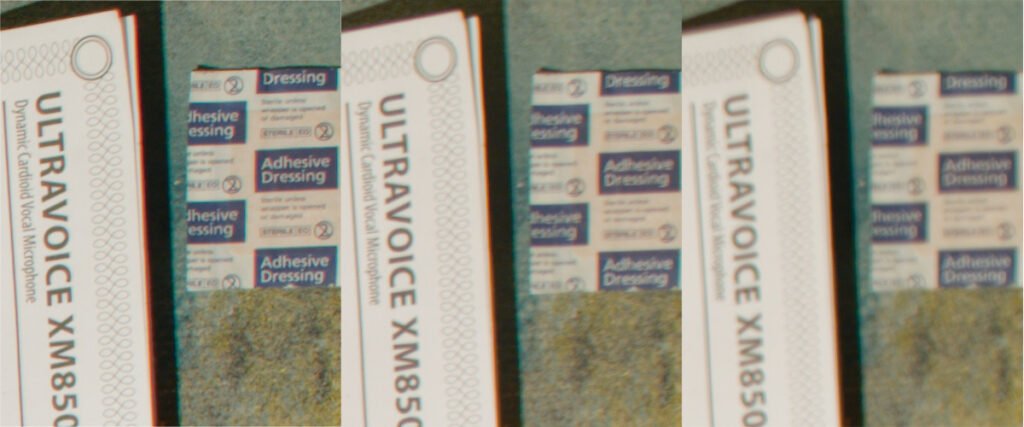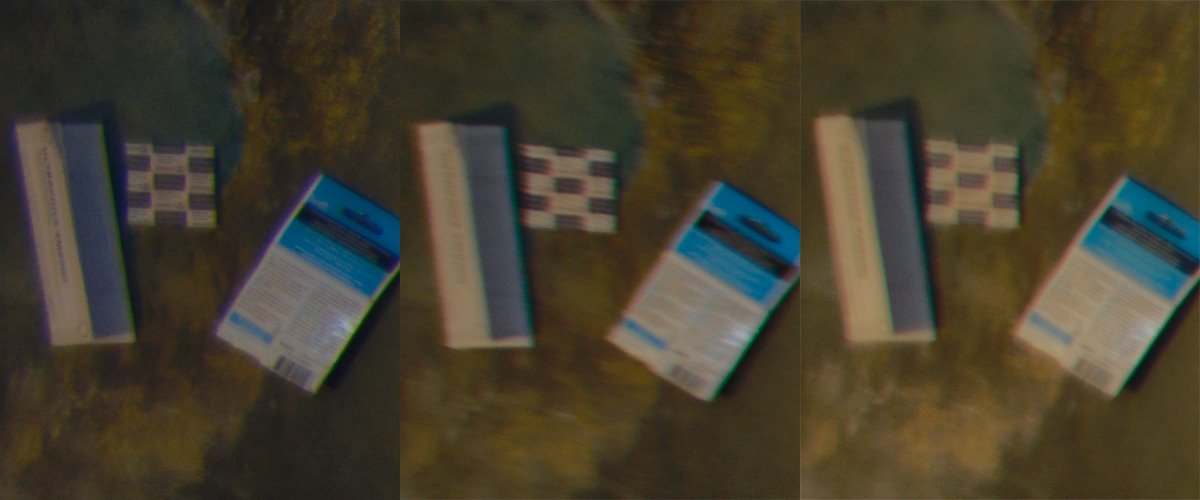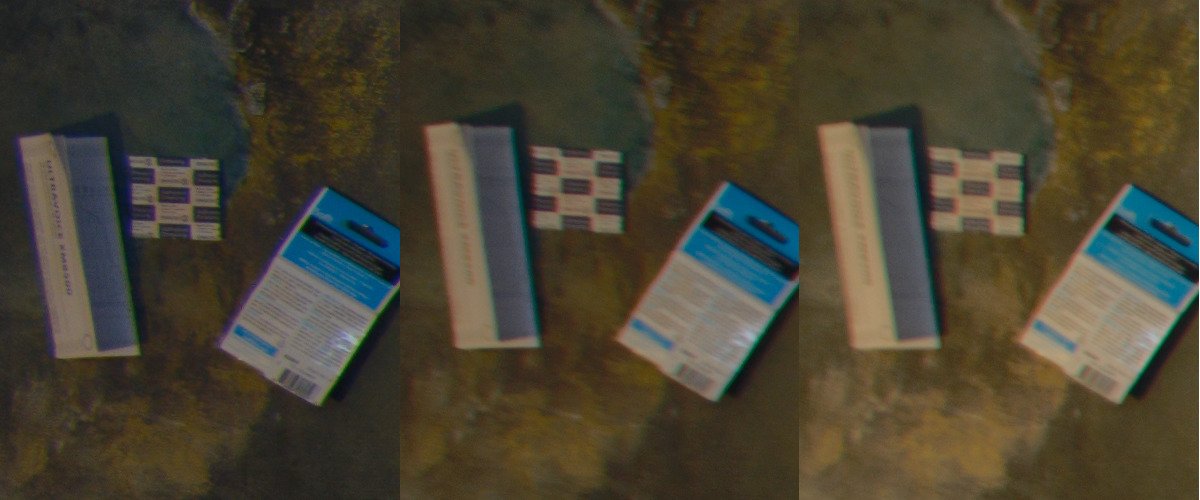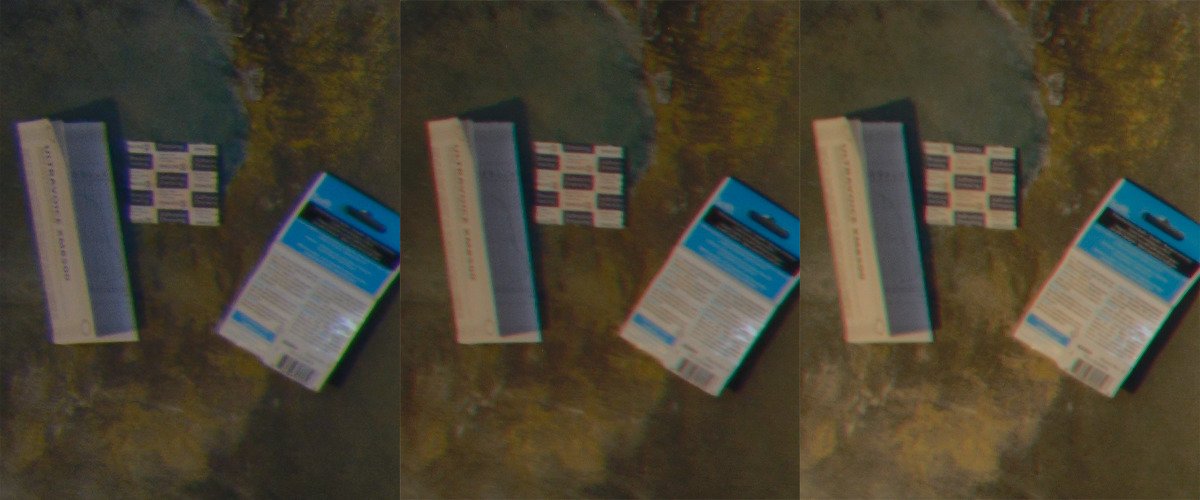Resolution (Unshifted)
For comparison we here include a capture at f5.6 by the Panasonic Lumix-S 20-60mm kit lens with lens profiling turned on. For more on our usage of ‘Zones’ and image circles, please see here >.
Centre-Frame (Zone 1) at f4

Lumix-S 20-60/4.5 at f5.6 | Olympus 35mm Shift f2.8 | Pentax FA35/3.5 | Pentax A SMC 35/3.5
Centre-Frame (Zone 1) at f5.6

Lumix-S 20-60/4.5 | Olympus 35mm Shift f2.8 | Pentax A SMC 35/3.5 | Pentax FA35/3.5
The manual focus Pentax 645 35mm is very soft at f4, but in Zone 1 improves significantly at f5.6. The autofocus version, while notably sharper wide open, doesn’t improve as much and lags behind the older lens all the way to diffraction-leveling. At f8, the Pentax A SMC 35/3.5 almost matches the Olympus 35/2.8 Shift, which is flat-out better resolving throughout the aperture range, and is comparable to a modern zoom from f4-f11 – in other words, entirely useable. Bear in mind that the Lumix-S benefits from additional sharpening as part of its DXO profiling, whereas the older lenses are here shown without it.
By f8 we see diffraction already taking its toll, blunting the relative excellence of the Olympus 35/2.8 and allowing the Pentax 645 lenses to catch up. The A SMC remains notably crisper-looking than the FA in Zone 1 at all apertures.
Centre-Frame (Zone 1) at f8

Lumix-S 20-60/4.5 at f5.6 | Olympus 35mm Shift f2.8 | Pentax A SMC 35/3.5 | Pentax FA35/3.5
Centre-Frame (Zone 1) at f11

Lumix-S 20-60/4.5 at f5.6 | Olympus 35mm Shift f2.8 | Pentax A SMC 35/3.5 | Pentax FA35/3.5
On a 4.3 micron test camera, diffraction-limiting dictates performance at f11 – and at f16 we only see more of the same. Centre-frame we can clearly see that (for these clean, healthy-seeming, individuals at least) the Olympus 35mm f2.8 Shift is a sharper, better-resolving lens at all apertures than the Pentax 645 optics, and that – surprisingly – apart from its maximum aperture failings, the older manual focus A SMC 35mm is a somewhat crisper than the later FA 35/3.5. My recollection of owning a new copy of this lens fifteen years ago was that it wasn’t as soft as the results I’m seeing here – but that was a less demanding camera, and a different sample.
Resolution (Shifted: Zone C)
The corner of a full-frame 35mm sensor sits at the inner edge of Zone C. The corner of a GFX sensor sits at the outer edge of Zone C. We have chosen a point in the middle of Zone C to give a fair idea of how corners of both format look, when averaged with our samples taken from Zone D below. These Zone C samples were taken using a right-shift of 8mm.
Zone C (‘Corner’) at f4

From left to right, in descending quality order:
Olympus 35/2.8 Shift | Pentax FA 35/3.5 | Pentax A SMC 35/3.5
The Olympus has the advantage of being a full stop down, compared to the Pentax medium format lenses operating almost wide open. It is remarkably sharper, however, albeit with strong chromatic aberration. The original manual focus 645 35/3.5 is poor here, with particularly strong sagittal aberration, though little CA.

Olympus 35/2.8 Shift | Pentax FA 35/3.5 | Pentax A SMC 35/3.5
At f5.6 the Pentax FA 35 corners leap to a moderately useful level, though there is also some colour fringing, and it’s some way off the pace set here by the Olympus Shift, which is performing better than I remember when it was compared to the Zeiss 35mm Distagon-PC under the scrutiny of fewer pixels. At this aperture, it’s still a struggle to focus critically with the A SMC 35/3.5. This capture (the sharpest of those bracketed) is probably improvable for accuracy, but it’s still a poor rendition.
Zone C (‘Corner’) at f8

Olympus 35/2.8 Shift | Pentax FA 35/3.5 | Pentax A SMC 35/3.5
The FA35 achieves a handy boost in Zone C resolution stopping down to this ‘working aperture’, and the manual focus lens begins to achieve a level of adequacy, too – though both still lag behind the Olympus.
Zone C (‘Corner’) at f11

Olympus 35/2.8 Shift | Pentax FA 35/3.5 | Pentax A SMC 35/3.5
Stopped down to f11, the sharpest (Olympus) still has the biggest CA issues, and vice-versa: the now useable A SMC, despite being the softest, has the fewest chromatic aberrations – though more than its fair share of spherical ones. Once again at f16 we see a levelling: across the frame, and between the candidates. You can probably image what that looks like.
Zone D (±15mm Shift for 35mm / ±8mm for GFX)
We bump against the limits of the Olympus’ image circle here: it was designed for 10mm shift movements, and we’ve adapted it in a way that permits 15mm movements: by rights it shouldn’t form an image out here in the darkest fringes of the Zone D badlands. It’s also not quite as wide a field of view, so we helped it out a fraction with a nudge of panning. Also, to average out potential de-centering, the following captures are left-shifted 15mm.
Zone D at f4

Olympus 35/2.8 Shift | Pentax FA 35/3.5 | Pentax A SMC 35/3.5
Can you hear the sound of screaming pixels? And yet, despite vignetting, and the torture we’re inflicting on these image circles (honestly, it hurts to rack these out to 15mm shift and max the aperture), the Olympus manages to deliver the least unusable image of the three.
Zone D at f5.6

Olympus 35/2.8 Shift | Pentax FA 35/3.5 | Pentax A SMC 35/3.5
Zone D at f8

Olympus 35/2.8 Shift | Pentax FA 35/3.5 | Pentax A SMC 35/3.5
Zone D at f11

Olympus 35/2.8 Shift | Pentax FA 35/3.5 | Pentax A SMC 35/3.5
One would need a pretty liberal defintion of ‘useable’ to find any of these lenses acceptable in Zone D, but once again the Olympus maintains a small advantage.
Resolution Summary
If sharpness was the only criterion, the Olympus 35/2.8 Shift is the obvious choice: nothing troubles its clear dominance in this group.
Comparing the Pentax 645 options is slightly tricker. The takeaways are:
- The FA 35 is sharper wide open across the frame
- The SMC is slightly sharper centre-frame (and in Zone 2, which we didn’t show) from f5.6-f11
- . . . but slightly softer in the outer image circle at all apertures
This kind of improvement is typical of next-generation redesigns: more advanced computation permits flatter performance across the image circle. However, the SMC must be commended for its superior sharpness at working apertures in Zone 1, and (you may have noticed) better behaviour in other metrics, which will be demonstrated shortly.
